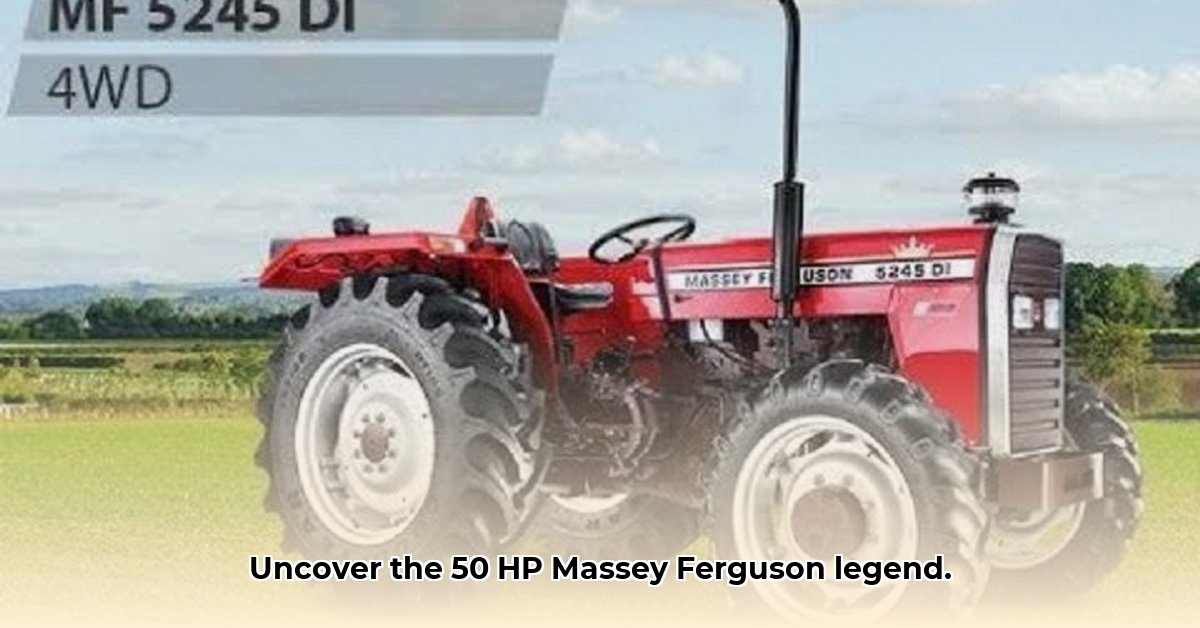
The Massey Ferguson 50, a stalwart of mid-20th-century agriculture, deserves more than a cursory glance. This article delves into its history, technical specifications, and lasting impact, offering a comprehensive look at this iconic workhorse. We’ll explore its engineering marvels and limitations, comparing it to contemporaries where data allows, and discuss the challenges of restoring these vintage machines. For more on similar models, check out the MF 40 information.
50 hp Massey Ferguson Tractor: A Technological Leap
Produced between 1957 and 1964, the Massey Ferguson 50 represented a significant advancement in agricultural technology. Its approximately 50 horsepower output, while modest by today's standards, was a substantial increase for many farmers at the time. This extra power translated to increased efficiency and the ability to cultivate larger land areas. But how did its performance stack up against competitors? Determining precise comparative data for drawbar pull and PTO power proves difficult due to the scarcity of readily available comprehensive specifications across different models and years. However, anecdotal evidence suggests it held its own against similar tractors of the era.
Powertrain and Performance: A Flexible Approach
The MF 50 offered farmers considerable flexibility in fuel choice, providing options for diesel, gasoline, or even liquefied petroleum gas (LPG) engines. This adaptability catered to regional variations in fuel availability and cost. The exact horsepower varied slightly depending on the engine type and model configuration, but it consistently delivered around the advertised 50 horsepower. The transmission options, either 6-speed or 12-speed, allowed for precise control and optimized performance across various farming tasks. Was this adaptability key to its success? The answer, based on its widespread adoption, appears to be a resounding yes.
Design and Construction: Robust and Reliable
The Massey Ferguson 50’s design prioritized ruggedness and longevity over stylistic flair. Its straightforward, durable components were designed for minimal downtime and maximum uptime – a crucial consideration for farmers. Later models incorporated features like power steering and front-end loaders, enhancing versatility and ease of use. This focus on reliability cemented its reputation as a dependable workhorse. How did this simple, robust design impact its longevity and its place in agricultural history? The answer lies in its continued presence in many farming communities even today, a testament to its sturdy engineering.
Massey Ferguson 50: Key Specifications (Approximate)
| Feature | Specifications | Notes |
|---|---|---|
| Engine Type | Diesel, Gasoline, LPG | Fuel choices offered considerable flexibility. |
| Horsepower | ~50 hp | Varied slightly depending on the engine and configuration. |
| Fuel Capacity | Data varies across sources; further research needed. | Precise figures are difficult to accurately ascertain. |
| Transmission | 6-speed or 12-speed | The 12-speed option offered greater control and efficiency. |
| PTO Power | Data varies across sources; further research needed. | Further investigation is necessary to establish reliable figures. |
| Drawbar Pull | Data varies across sources; further research needed. | The drawbar pull varied based on numerous factors, including engine type. |
Note: The data presented reflects general specifications; exact figures varied depending on engine type, transmission, and year of manufacture. Further research is needed to compile a more comprehensive dataset.
Restoring a Massey Ferguson 50: A Labor of Love and Precision
Restoring a vintage Massey Ferguson 50 tractor presents a unique challenge. It requires careful planning, extensive research, and considerable mechanical skill. The process, however, offers a rewarding experience for those interested in agricultural history and sustainable practices.
Essential Steps in Restoring a Vintage MF50:
- Thorough Assessment: Initiate with a comprehensive inspection, documenting all damage, missing parts, and the overall condition of the tractor. This detailed assessment forms the foundation of your restoration plan.
- Parts Sourcing: Locating original parts can be challenging. Explore online communities, salvage yards, and specialist suppliers. Be prepared for creative problem-solving and potentially fabricating some components.
- Disassembly and Cleaning: Methodically dismantle the tractor, photographing each step for careful reassembly. Clean all parts thoroughly, addressing rust and corrosion appropriately.
- Repair and Replacement: Repair or replace damaged parts, prioritizing critical systems like the engine, transmission, hydraulics, and electrical components.
- Reassembly and Testing: Reassemble the tractor, referencing your documentation. Test each system rigorously to ensure proper functionality.
- Finishing Touches: Once functionality is confirmed, address cosmetic restoration, including repainting and detailing.
Safety Precautions: Throughout this process, prioritize safety by disconnecting the battery, wearing appropriate protective gear, and handling fluids and chemicals carefully. If you lack experience with machinery repair, seek professional assistance.
The Lasting Legacy of the Massey Ferguson 50
The Massey Ferguson 50 played a crucial role in transforming agricultural practices, offering farmers a powerful and dependable tool. While modern tractors greatly surpass its capabilities, the MF 50's impact remains significant, representing a milestone in agricultural mechanization. Its durable construction and adaptable design continue to inspire appreciation for its lasting impact and its enduring appeal for collectors and restoration enthusiasts. The challenges of restoring these vintage machines highlight both the ingenuity of its original design and the passionate commitment to preserving its legacy.